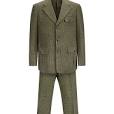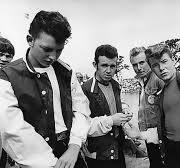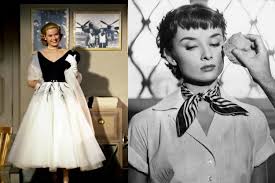Elevate Your Style: Embrace the Timeless Charm of Vintage Men’s Clothing
The Timeless Appeal of Vintage Men’s Clothing
When it comes to fashion, the past often holds the key to timeless style. Vintage men’s clothing has a unique charm and character that sets it apart from modern trends. From classic suits to retro accessories, vintage pieces offer a sense of nostalgia and sophistication that is hard to replicate.
One of the main attractions of vintage men’s clothing is its quality. In bygone eras, garments were made with meticulous attention to detail and craftsmanship. Fabrics were chosen for their durability and comfort, resulting in clothing that stood the test of time. Today, vintage pieces retain their original quality, making them a sustainable and eco-friendly choice for the fashion-conscious man.
Another appeal of vintage men’s clothing is its individuality. With vintage pieces, you can create a look that is truly your own. Whether you prefer the sleek lines of 1960s mod fashion or the rugged charm of 1970s workwear, there is a vintage style to suit every taste and personality.
Furthermore, wearing vintage men’s clothing allows you to make a statement against fast fashion and mass production. By choosing pre-loved garments, you are supporting ethical consumption practices and promoting a more sustainable approach to fashion.
From timeless tweed jackets to classic leather brogues, vintage men’s clothing offers endless possibilities for creating sophisticated and stylish outfits. So why not add a touch of history and elegance to your wardrobe with some carefully curated vintage pieces?
Essential FAQs on Vintage Men’s Clothing: Definition, Sourcing, Styling, and Care
- What defines vintage men’s clothing?
- Where can I find authentic vintage men’s clothing?
- How can I distinguish between vintage and retro men’s clothing?
- What are the popular eras for vintage men’s fashion?
- Are there specific care instructions for maintaining vintage men’s clothing?
- Can vintage men’s clothing be altered or tailored to fit modern sizes?
- Is it common for vintage men’s clothing to have signs of wear or aging?
- What are some key tips for styling and incorporating vintage pieces into a modern wardrobe?
What defines vintage men’s clothing?
Vintage men’s clothing is defined by its age and historical significance. Typically, clothing is considered vintage if it dates back to a specific era, often around 20-30 years or more. Vintage pieces often reflect the styles, trends, and craftsmanship of their time, showcasing unique design elements that set them apart from modern clothing. Additionally, vintage men’s clothing is known for its quality materials, attention to detail, and timeless appeal that transcends fleeting fashion trends. Embracing vintage men’s clothing allows individuals to connect with the past while adding a touch of character and sophistication to their wardrobe.
Where can I find authentic vintage men’s clothing?
For those seeking authentic vintage men’s clothing, there are various avenues to explore. Thrift stores, flea markets, and vintage shops are popular destinations where hidden gems can be discovered. Online marketplaces and auction websites also offer a wide selection of vintage pieces from different eras. Additionally, specialised vintage clothing fairs and events provide a curated collection of authentic items for enthusiasts to peruse. By exploring these diverse sources, one can uncover unique and genuine vintage men’s clothing that adds character and history to their wardrobe.
How can I distinguish between vintage and retro men’s clothing?
Distinguishing between vintage and retro men’s clothing can often be a matter of understanding the nuances of each style. Vintage clothing refers to garments that are typically at least 20 years old, reflecting the fashion trends of a specific era. These pieces are authentic and original, showcasing the craftsmanship and design aesthetic of their time. On the other hand, retro clothing is inspired by past eras but is newly produced to mimic vintage styles. Retro pieces often incorporate modern elements or fabrics while paying homage to classic designs. By examining the quality, materials, and design details of a garment, you can better determine whether it is truly vintage or a modern interpretation of a bygone era.
What are the popular eras for vintage men’s fashion?
When exploring vintage men’s fashion, it’s fascinating to delve into the popular eras that have left a lasting impact on style. Some of the most sought-after periods in vintage men’s clothing include the sleek and sophisticated 1920s with its tailored suits and elegant accessories, the rebellious and rugged 1950s with its iconic leather jackets and denim jeans, and the vibrant and eclectic 1970s with its bold patterns and statement pieces. Each era brings its own unique charm and influences, allowing men to embrace different styles that resonate with their individual tastes and preferences.
Are there specific care instructions for maintaining vintage men’s clothing?
When it comes to maintaining vintage men’s clothing, special care instructions are essential to preserve the quality and longevity of these timeless pieces. Due to the age and delicate nature of vintage garments, it is crucial to handle them with care. Gentle hand washing or dry cleaning may be necessary, depending on the fabric and construction of the clothing. Additionally, storing vintage men’s clothing in a cool, dark place away from direct sunlight can help prevent fading and damage. Regular inspections for signs of wear or moth damage are also recommended to address any issues promptly. By following specific care instructions tailored to each vintage piece, you can ensure that your collection remains in pristine condition for years to come.
Can vintage men’s clothing be altered or tailored to fit modern sizes?
Vintage men’s clothing can often be altered or tailored to fit modern sizes, depending on the garment’s construction and fabric. Skilled tailors can adjust the waistline, sleeve length, hemline, and other aspects of vintage clothing to achieve a better fit without compromising the integrity of the piece. However, it’s essential to consider the original design and structure of the garment before making alterations to ensure that its unique vintage charm is preserved. With careful alterations, vintage men’s clothing can be transformed into stylish and well-fitting pieces that seamlessly blend classic aesthetics with contemporary trends.
Is it common for vintage men’s clothing to have signs of wear or aging?
It is quite common for vintage men’s clothing to exhibit signs of wear or aging. Due to the nature of these garments being pre-owned and often decades old, some level of wear and tear is expected. This can include minor imperfections such as fading, fraying seams, or small holes, which can add character and authenticity to the piece. Embracing these signs of aging is part of the charm of wearing vintage clothing, as they tell a story of the garment’s history and previous life. With proper care and maintenance, vintage men’s clothing can continue to be enjoyed for years to come, showcasing its enduring quality and timeless appeal.
What are some key tips for styling and incorporating vintage pieces into a modern wardrobe?
When it comes to styling and incorporating vintage pieces into a modern wardrobe, there are a few key tips to keep in mind. Firstly, mix and match your vintage items with contemporary pieces to create a balanced look that feels fresh and current. Consider layering a vintage blazer over a plain t-shirt and jeans for a stylish contrast. Secondly, pay attention to fit and tailoring – ensure that your vintage pieces are altered to suit your body shape and proportions for a more polished appearance. Lastly, don’t be afraid to experiment with accessories such as hats, belts, or scarves to add a unique touch to your outfit. By following these tips, you can effortlessly blend vintage charm with modern style to create a distinctive and fashion-forward wardrobe.


